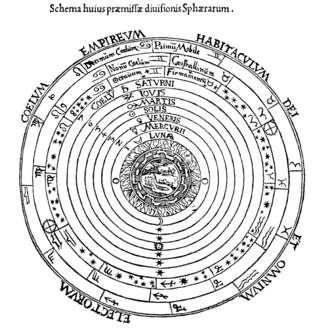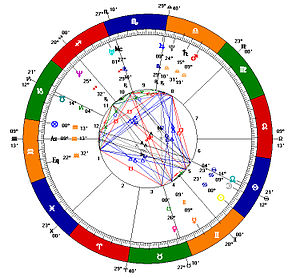
The zodiac is a belt-shaped region of the sky that extends approximately 8° north and south of the ecliptic, the apparent path of the Sun across the celestial sphere over the course of the year. Also within this zodiac belt appear the Moon and the brightest planets, along the their orbital planes. The zodiac is divided along the ecliptic into 12 equal parts ("signs"), each occupying 30° of celestial longitude. These signs roughly correspond to the astronomical constellations with the following modern names: Aries, Taurus, Gemini, Cancer, Leo, Virgo, Libra, Scorpio, Sagittarius, Capricorn, Aquarius, and Pisces.

Western astrology is the system of astrology most popular in Western countries. Western astrology is historically based on Ptolemy's Tetrabiblos, which in turn was a continuation of Hellenistic and ultimately Babylonian traditions.

Most horoscopic traditions of astrology systems divide the horoscope into a number of houses whose positions depend on time and location rather than on date. In Hindu astrological tradition these are known as Bhāvas. The houses of the horoscope represent different fields of experience wherein the energies of the signs and planets operate—described in terms of physical surroundings as well as personal life experiences.

In astrology, an aspect is an angle that planets make to each other in the horoscope; as well as to the Ascendant, Midheaven, Descendant, Lower Midheaven, and other points of astrological interest. As viewed from Earth, aspects are measured by the angular distance in degrees and minutes of ecliptic longitude between two points. According to astrological tradition, they indicate the timing of transitions and developmental changes in the lives of people and affairs relative to the Earth.
Hindu astrology, also called Indian astrology, or Jyotisha ; from jyót "light, heavenly body", and more recently Vedic astrology, is the traditional Hindu system of astrology. It is one of the six auxiliary disciplines in Hinduism that is connected with the study of the Vedas.

The ascendant or rising sign is the astrological sign on the eastern horizon when the person was born. It signifies a person's physical appearance, and awakening consciousness.

In astrology, sidereal and tropical are terms that refer to two different systems of ecliptic coordinates used to divide the ecliptic into twelve "signs". Each sign is divided into 30 degrees, making a total of 360 degrees. The terms sidereal and tropical may also refer to two different definitions of a year, applied in sidereal solar calendars or tropical solar calendars.

In Western astrology, astrological signs are the twelve 30-degree sectors that make up Earth's 360-degree orbit around the Sun. The signs enumerate from the first day of spring, known as the First Point of Aries, which is the vernal equinox. The astrological signs are Aries, Taurus, Gemini, Cancer, Leo, Virgo, Libra, Scorpio, Sagittarius, Capricorn, Aquarius, and Pisces. The Western zodiac originated in Babylonian astrology, and was later influenced by the Hellenistic culture. Each sign was named after a constellation the sun annually moved through while crossing the sky. This observation is emphasized in the simplified and popular sun sign astrology. Over the centuries, Western astrology's zodiacal divisions have shifted out of alignment with the constellations they were named after by axial precession of the Earth while Hindu astrology measurements correct for this shifting. Astrology was developed in Chinese and Tibetan cultures as well but these astrologies are not based upon the zodiac but deal with the whole sky.

Mundane astrology, also known as political astrology, is the branch of astrology dealing with politics, the government, and the laws governing a particular nation, state, or city. The name derives name from the Latin term mundus, 'world'.

Natal astrology, also known as genethliac astrology or genethlialogy, is a system of astrology that claims to shed light on an individual’s personality or path in life based on constructing a horoscope or natal chart that includes the exact date, time, and location of an individual's birth. Natal astrology is found in the Indian, Chinese, Hellenistic and Western astrological traditions.
In astrology, the Imum Coeli is the point in space where the ecliptic crosses the meridian in the north, exactly opposite the Midheaven. It marks the fourth house cusp in most house systems.

In astrology, a planet's domicile is the zodiacal sign over which it has rulership. This is a separate concept from the houses of the horoscope. A planetary ruler is given to each sign, over which the planet is said to have a more powerful influence when positioned therein. The ruling planet associated with a sign is also used as an implied focus of interpretation for the signs on house cusps in a chart. A planet is considered to be in domal dignity when it is positioned in the sign it rules. This is the strongest of the five essential dignities of a planet. Domicile is an archaic term in infrequent, specialist uses today; most astrologers use the simpler term "sign".

In astrology, an angular house, or cardinal house, is one of four cardinal houses of the horoscope, which are the houses in which the angles of the chart are found. The angular houses of the horoscope are considered to be the most ardent, or forceful, and are considered to have the greatest impact in the chart. The influential 17th-century astrologer William Lilly states simply: "Planets in angles do more forcibly show their effects." Angular houses rule those critical things in our life, such as our appearance and how we behave, our family life, our married life or partnerships, and our career.

Horoscopic astrology is a form of astrology that uses a horoscope, a visual representation of the heavens, for a specific moment in time to interpret the purported meaning behind the alignment of the planets at that moment. The idea is that the placement of the planets at any given moment in time supposedly reflects the nature of that moment and especially anything that is born then, and proponents claim that this can be analyzed using the chart and a variety of rules for interpreting the "language" or symbols therein.

In astrology, certain stars are considered significant. Historically, all of the various heavenly bodies considered by astrologers were considered "stars", whether they were stars, planets, other stellar phenomena like novas and supernovas, or other solar system phenomena like comets and meteors.

Astrological progressions are one of the main means used in Horoscopic astrology to forecast future trends and developments. As its name implies, astrological progression involves a method of progressing the Horoscope forward from the moment of the birth or beginning of the subject into the future, and is most usually done for the birth or natal chart of a particular individual.

Heliocentric astrology is an approach to astrology centered around birth charts cast using the heliocentric model of the Solar System, positioning the Sun at the center. In contrast to geocentric astrology, which places Earth at the center, heliocentric astrology interprets planetary positions from the Sun's vantage point. While geocentric astrology considers elements like the ascendant, midheaven, houses, Sun, Moon, and planetary aspects, heliocentric astrology focuses primarily on planetary aspects and configurations. Astrologers often use this method in conjunction with geocentric astrology to access insights beyond the traditional framework.

Primary direction is a term in astrology for referencing one of the oldest methods of predicting events. It indicates the year of life in which an event shown by the birth chart will occur. This method has been around for over 1800 years and is mentioned in the Tetrabiblos of Claudius Ptolemy in the section on calculating the length of life. It gained widespread popularity in medieval Europe and was thoroughly described by Jean-Baptiste Morin in the 22nd book of his Astrologia Gallica.











